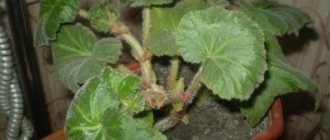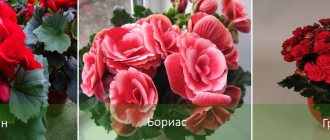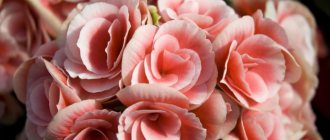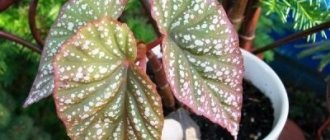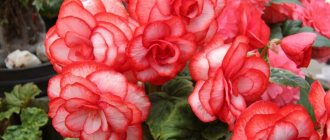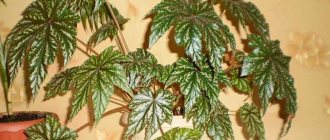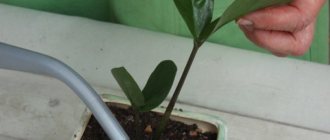What is tuberous begonia?
Tuberous begonia is a hybrid; it was obtained as a result of complex selection. Work on creating the plant began in the 19th century. The plant has a strong stem. The height reaches 60–80 cm. The leaves are large, can be completely glossy or covered with small fibers.
The flowering period is long - from May to October. The color can be varied. There are double, fringed, non-double, serrated and folded flowers. Depending on the variety, the diameter of the flower varies from 3 to 20 cm. With proper planting and care, flowering will be abundant and long-lasting.
Main types and varieties
There are several types of tuberous begonia: erect and ampelous. They have a large number of varieties.
Varieties of erect tuberous begonia
Most varieties of tuberous begonia are erect. They are distinguished by fleshy stems. Popular varieties:
- Picotee Harlequin. The flower grows up to 25 cm. It has large double yellow flowers. There is a small red border. The petals are arranged in tiers, so the flower looks like a cone.
- Bouton De Rose. Low plant. It has double pink flowers with a diameter of up to 18 cm. The color is white and pale pink. The contrast of the border depends on the presence of sunlight and the level of air humidity.
- Dark Red. The low-growing bush has peony-shaped flowers of dark red color. They grow up to 10 cm in diameter.
- Crispa Marginata. Spreading flower, maximum height - 15 cm. The shape of the flowers resembles pansies. Color - white or pale yellow. There is a red border.
There are also erect begonias of the varieties Crispamarginata and Samba.
Varieties of cascading or ampel tuberous begonia
Ampelous begonia is distinguished by long and flowing stems with a large number of flowers. The most popular variety is Chanson. It has a large number of shades. The following varieties are distinguished:
- Begonia Boliviensis;
- Santa Cruz Sunset;
- Copacabana;
- Bossa Nova.
The shoots of Begonia Boliviensis first grow upward, and upon reaching 30 cm they begin to fall down and form a multi-tiered cascade. Shoots of Santa Cruz Sunset grow up to 40 cm. This variety is distinguished by red-orange fuchsia-shaped flowers. It is perfect for growing in pots.
Copacabana is an easy-to-care variety that tolerates excess sun. The plant has bell-shaped red flowers. The shoots of Bossa Nova reach 50 cm. The color is red, pink and orange. The flower has a fuchsia shape.
Planting tuberous begonia at home
In order for tuberous begonia to delight with flowering, it must be planted correctly. All rules of agricultural technology must be followed. It is important to buy high-quality seed material.
What time of year is best to plant a flower?
In autumn and winter the plant remains dormant. It is recommended to plant the flower in early March. In this case, the begonia will quickly enter the vegetative stage.
How to choose the right tubers when buying
In many specialized stores, the sale of begonia tubers begins at the end of January. Main criteria for choosing planting material:
- absence of light spots;
- dark brown and uniform color;
- size no more than 4 cm;
- the presence of a depression on the top of the tuber.
It is not recommended to buy tubers that are too small. It is necessary to pay attention to the weight; if it is too small, there is a risk that the material is too dry. Such a tuber may not germinate.
Tubers purchased at the end of February or beginning of March should have awakening buds.
How to awaken tuberous begonia from the store?
To awaken tuberous begonia, it is necessary to create certain conditions. The optimal temperature for germination is 22–24 degrees. The tubers should always be on something damp and should not be exposed to sunlight.
If the tubers are partially buried in the ground and placed on a cold windowsill, they will take a very long time to sprout. The risk of rotting increases several times.
Treatment with drugs
Before planting, begonia tubers are soaked in a growth stimulator. It is recommended to use the drug Stimul or Epin. Treatment with a weak solution of fungicide or potassium permanganate will help reduce the risk of rotting.
Tuber preparation
The tubers must first be properly prepared for planting. They must be cleaned of rotten sprouts. If the onion is too large, it needs to be divided into several parts. The cut site is sprinkled with charcoal.
All manipulations with tubers should be performed as carefully as possible. They should not be dropped or squeezed.
Optimal soil composition
For good plant growth, it is necessary to choose the correct soil composition. Begonias prefer a nutritious and loose substrate with a neutral acid reaction. Soil composition:
- deciduous soil;
- peat;
- sand.
For 1 part sand and peat, take 3 parts deciduous soil. If desired, you can add a small amount of rotted cow manure.
Which pot is better to choose?
For planting begonias, it is recommended to choose wide but shallow pots. The plant has a shallow root system, so it will grow wider. The volume of the container should not be less than 3 liters.
This type of begonia does not have roots or fibers that will cling to the surface, so the material of the pot does not matter. You can use a plastic or ceramic container.
How to plant tubers
Initially you need to create a drainage layer. The pot is filled ⅓ full with expanded clay or other material. The prepared tuber is placed in a container filled with substrate. To do this you need to make a small recess. The tuber is placed in the ground with its growth points facing upward. It should be sprinkled so that the buds remain open.
When the young shoots grow to 4–5 cm, you need to add a little substrate to completely cover the tuber.
Caring for tuberous begonia after planting
It is recommended to place the begonia pot in a sunny place, but it should not be exposed to direct rays. A window sill with east and west windows is best suited. If the sun is too active, you need to create shade with a curtain or other plants.
The optimal temperature is 20–22 degrees. This is a tropical plant, so it needs adequate moisture. The soil should always be moderately moist. Water should not get on the tuber itself, as it may begin to rot.
Rules for planting seedlings in open ground
The first step is to find a place to land. It should be well lit, but at the same time protected from direct sunlight and strong winds. The plant is planted in early June.
The tuber is pre-treated in a fungicidal solution and germinated. A plant with young shoots should be gradually prepared for planting outside. To do this, the flower is first taken out onto the balcony, and then simply into the fresh air. The duration of stay in the fresh air should gradually increase.
Preparing the planting site involves creating planting holes and filling them with ash or rotted humus. Then the plant is planted. Seedlings should be mulched immediately. Large tubers are planted at a distance of 30 cm from each other, medium ones 20 cm, and small ones - every 15 cm.
How to properly store tubers
In winter, begonia tubers can be stored in an apartment or basement. Each of these options has its own nuances.
Storage in the apartment
In an apartment, it is recommended to store flower tubers in a cool place. This could be a place under a window or balcony door. The temperature should be in the range from 0 to 9 degrees.
There are 3 main storage options:
- In a box or crate. The tubers are sprinkled with sand, sawdust or peat.
- In pots. The container is transferred to a cool place, and all the green part is cut off. The soil needs to be watered periodically, it should remain slightly moist.
- In a refrigerator. The tubers are thoroughly dried, placed in bags with holes and wrapped in paper. They are best stored in the bottom of the refrigerator with fruits and vegetables.
When stored in pots there is a risk of rotting. To avoid this, the soil should be watered through a tray.
Basement storage
The basement should be dry and cool. A cellar for storing begonias is not suitable. It contains high humidity and planting material can begin to rot. The tubers are placed in a box or box. They must be covered with sawdust or sand.
Sowing seeds
To plant flowers, you should prepare a special soil of sand, earth and peat. In order for the seeds to germinate quickly, you need to provide the flowers with good lighting, high humidity and a stable temperature. When to sow begonia seeds? It is best to plant the plant in winter.
Keep in mind that the soil should not dry out too much, so do not leave the seeds in the sun. It is advisable to cover the top of the pot with glass until the first shoots appear.
How to grow begonia from seeds? It is advisable to feed young plantings with fertilizers containing nitrogen. And when the begonia bushes grow up, they can be transplanted into separate pots.
Caring for tuberous begonia
Caring for begonias in open ground involves timely watering and fertilizing. Particular attention is paid to preparing the plant for wintering.
Lighting and locations
The plant should not be in the scorching sun. The light should be diffused. In the first month after planting, it is recommended to shield the flower from the sun with greenhouse film.
Temperature
Temperature is important for normal development. Optimal values are from 10 to 15 degrees. At low temperatures the flower will grow very slowly.
Watering and air humidity
Proper watering will help maintain flowering even in the hottest weather. The plant needs to be moistened early in the morning. The water should be warm. Daytime watering is dangerous due to the formation of burns and falling leaves. If you use cold water, the roots will die.
After completion of the active flowering phase, the amount of watering should be gradually reduced.
Feeding
In order for the plant to tolerate heat normally, it must be sprayed with growth substances. For example, Gumate, Zircon or Epin. Potassium nitrate improves the condition of foliage. After planting, it must be applied 2-3 times at weekly intervals.
After this, complex fertilizers are applied, with a small amount of nitrogen. If there is too much nitrogen, the begonia may begin to rot in wet weather. The last feeding is carried out in early October.
Wintering begonias
Closer to autumn, the leaves of the plant begin to turn yellow. At this time, you need to remove all buds and flowers. Feeding is stopped and watering is reduced to a minimum. Tubers are dug up before the first frost. They must be dried thoroughly in a warm room. The greens should dry completely.
The tubers are placed in sand or soil and stored at a temperature of 5–7 degrees. Periodically you need to moisten the soil and check the condition of the tubers. Planting material should not freeze.
Bloom
Club begonia is one of the ornamental plants. It has simple, double, two-color, large and small flowers. The flowering period lasts throughout the summer.
When to plant
The dormant period of tuberous begonias ends around the end of February. You can tell when it’s time to plant tubers by looking at swollen or already sprouting buds. Some tubers “wake up” in April, so you need to monitor their condition from February. You can speed up the awakening if you place the planting material in a well-lit place, but away from direct rays of the sun.
Begonias that have overwintered in pots with soil are simply placed in a bright place and begin to moisten.
Tuberous begonias are planted in a flowerbed after the soil has warmed up and warm weather has established with above-zero temperatures even at night. Therefore, the timing of planting in open ground depends on weather conditions in your region.
Propagation of tuberous begonia
There are several options for propagating tuberous begonia. This can be done by seed, dividing tubers or cuttings.
Growing tuberous begonia from seeds
This propagation method allows you to preserve the varietal characteristics of the plant. The growing process itself is long and labor-intensive. Seeds should be scattered on damp soil and covered with polyethylene. Place the container in a sunny place and spray it with water daily. Once a day, open the pot for an hour. If this is not done, the seeds may begin to rot from dampness. The optimal room temperature is 24 degrees.
The seeds should sprout in 2 weeks. When the sprouts have 2-3 leaves, they can be placed in cups.
Tuber division
For division, it is best to take old tubers. It is recommended to carry it out in early spring. Until the sprouts reach 4–5 cm, the tuber can be divided into several parts without damaging the plant itself. The cut areas are treated with charcoal powder or a special preparation.
After dividing, parts of the tubers are placed in different pots. Next, they need to be cared for as full-fledged plants.
Propagation of tuberous begonia by cuttings
Cuttings are the fastest and easiest method of plant propagation. You will need a shoot 10 cm long with several leaves. The cut is sprinkled with charcoal powder. Rooting should be done in moist soil in a bright and warm place. The soil should not touch the leaves of the cutting.
The planted cuttings are covered with a jar and ventilated daily. After 3 weeks it can be transplanted into a pot.
Care after shoots appear
The first shoots from the buds should appear approximately three weeks after planting. When the shoots reach a height of 2-3 cm, the weakest ones are removed by sprinkling the wounds with crushed activated carbon (you can use wood ash).
Attention! It is recommended to leave no more than 5 shoots for small-flowered begonias and 3 for large-flowered ones. Also, the number of shoots depends on the size of the tuber. It is better not to leave more than 3 shoots on small ones.
Feeding is very important for tuberous begonias. It is recommended to feed them with complex fertilizers, which include both organic and mineral fertilizers. You can also use wood ash for feeding. The plants are fed for the first time after a leaf appears on them.
Two weeks before planting in the flowerbed, begonias begin to get accustomed to the open air. To do this, in warm weather they are taken out to an open balcony or area. On the first day, hardening should take place for one hour, and then the hardening time increases every day. By the time of planting, the flowers should be outside both day and night.
Questions and answers
How long does a flower live?
The lifespan of begonia is 2–3 years. However, some varieties with proper care can grow for up to 5 years. The tuberous begonias sold in stores are second-year plants. To rejuvenate a tuber, it should be divided.
How to care for tuberous begonia in autumn?
In autumn, the plant begins a state of dormancy. It lasts until spring. At this time, all excess leaves and shoots are removed. Watering is kept to a minimum. At a temperature of 10 degrees, the plant should be removed to a cool place.
How to wake up tuberous begonia
If the begonia tuber cannot be awakened, then it may be too dry. He can be revived. There are several ways. The first option is to wrap the tuber in a wet towel and place it in a plastic bag. It should be placed near the heating device. The tuber needs to be ventilated once a week.
The second option is to wrap the tuber in a damp cloth, perlite or moss. The plant is placed in a greenhouse.
How many days does it take for begonia to sprout?
In most cases, begonia seeds germinate in 10 days. However, the germination period can last from 8 to 26 days. Tubers begin to sprout only after a few weeks. First they form roots, and only then shoots.
Is it possible to pinch tuberous begonia?
Tuberous begonias do not pinch. Strongly grown shoots are simply suspended or attached to a high base. Hybrid tuberous begonias branch well without pinching.
At what depth should I plant tuberous begonia?
It is recommended to plant the tubers of the plant at a depth of about 5 cm. However, experienced gardeners recommend planting the plant so that the buds are visible. The soil is added as the shoots grow.
How to distinguish tuberous begonia from root begonia
The main difference between tuberous begonia and root begonia is the presence of tubers. This flower can be grown as a perennial garden plant or as an indoor plant. The thickness of the rhizome-tuber is about 5–6 cm. The stem itself is quite thin, but strong.
Why do tuberous begonia leaves curl?
Curling of leaves during the initial stages of growth is normal. This temporary modification will not affect the further development of the flower. This phenomenon is observed because the roots are still weak and the leaves do not have enough moisture.
To ensure normal self-regulation of humidity, a good drainage layer should be made. In this case, a sufficient amount of moisture will enter the leaves and they will not curl.
Features of transplantation
Begonia needs to be replanted infrequently, since its roots do not like to be disturbed. Due to their fragility, they are easily damaged.
But if it has already come to replanting, then do it in early spring, when the begonia has not yet begun to actively grow. If the flower is young, it will easily accept movement. It can be watered immediately and returned to its permanent place.
How do you know when it’s time to replant a flower? Pay attention to the roots: if they have grown greatly, then it’s time to start replanting. This must be done very carefully so as not to inadvertently damage the thin roots of the begonia.
Before you remove a flower from its old “place of residence,” be sure to water it. Then carefully remove, shake lightly and place in a solution of potassium permanganate for a couple of minutes. Then rinse the roots with water and dry. Now the plant can be placed in a new pot, placing drainage and soil down.
Diseases and pests
Begonia is a capricious plant that needs constant care. If agricultural practices are violated, the flower may be attacked by insects and become sick.
Main pests:
- leaf nematode;
- greenhouse aphid;
- spider mite
The nematode attacks young shoots and buds, as a result the plant dies. To eliminate the pest, flower bushes must be treated with heterophos. Affected areas of the plant are removed and burned.
Greenhouse aphids feed on plant sap. To get rid of it, it is recommended to use tobacco infusion, soap solution or insecticides.
Spider mites form thin webs on leaves. After this they turn yellow and fall off. With severe infection, flowering stops and the plant dies. To combat spider mites, it is recommended to spray with an infusion of onion and garlic. Near the plant itself you need to place a container with chopped garlic.
Possible diseases:
- Powdery mildew. It affects the above-ground part of the plant. White spots of plaque appear and the leaves begin to dry out. To treat the flower, fungicides or a copper-soap solution are used.
- Gray rot. This fungal disease appears as gray spots. The plant needs to be treated with Benomyl.
- Bacterial spotting. Forms on the lower leaves in the form of small watery spots. For treatment, spraying with a systemic fungicide is carried out.
- Tomato virus. Yellow-green spots form on the leaves. Affected plants are destroyed.
The main reason for the development of diseases is constant waterlogging, which promotes the proliferation of pests. Improper care leads to the development of diseases.
Watering rules
Begonia requires plenty of moisture, especially in summer. But you should wait some time between waterings so that the top layer of soil has time to dry out at least a couple of centimeters. In winter, begonia needs to be watered much less frequently and very little at a time, since at this time the flower has a dormant period.
Water for irrigation should be prepared in advance. It should sit for several days and be at room temperature. Remember: cold water causes the rhizomes to rot. Never pour water on the leaves - it will ruin them.
Some difficulties when growing tuberous begonia
When growing tuberous begonia, an inexperienced grower may encounter a number of problems. The main ones:
- yellowness of leaves - lack of light or insufficient watering;
- brown tips of leaves - the air in the room is too dry;
- buds falling off - too much moisture;
- leaf falling means lack of light.
You can get rid of such problems only by eliminating the cause. Further proper care will help to avoid them.
Tuberous begonia can be used both as an ornamental plant in the garden and as a home flower. To ensure abundant and lush flowering, maintain the correct temperature and water conditions.
